warning MITSUBISHI COLT 2008 Owner's Manual (in English)
[x] Cancel search | Manufacturer: MITSUBISHI, Model Year: 2008, Model line: COLT, Model: MITSUBISHI COLT 2008Pages: 450, PDF Size: 14.57 MB
Page 356 of 450
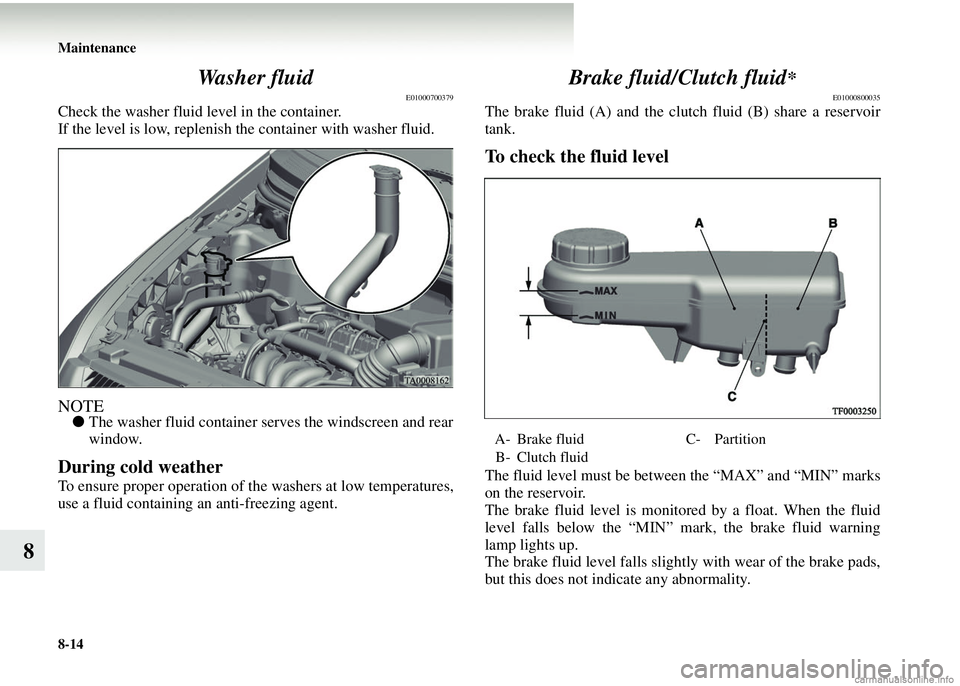
8-14 Maintenance
8Wa s h e r f l u i d
E01000700379
Check the washer fluid level in the container.
If the level is low, replenish the container with washer fluid.
NOTE●
The washer fluid container serves the windscreen and rear
window.
During cold weather
To ensure proper oper ation of the washers at low temperatures,
use a fluid containing an anti-freezing agent.
Brake fluid/Clutch fluid*
E01000800035
The brake fluid (A) and the clutch fluid (B) share a reservoir
tank.
To check the fluid level
The fluid level must be between the “MAX” and “MIN” marks
on the reservoir.
The brake fluid level is monitored by a float. When the fluid
level falls below the “MIN” mark, the brake fluid warning
lamp lights up.
The brake fluid level falls slightly with wear of the brake pads,
but this does not indicate any abnormality.
A- Brake fluid C- Partition
B- Clutch fluid
Page 360 of 450
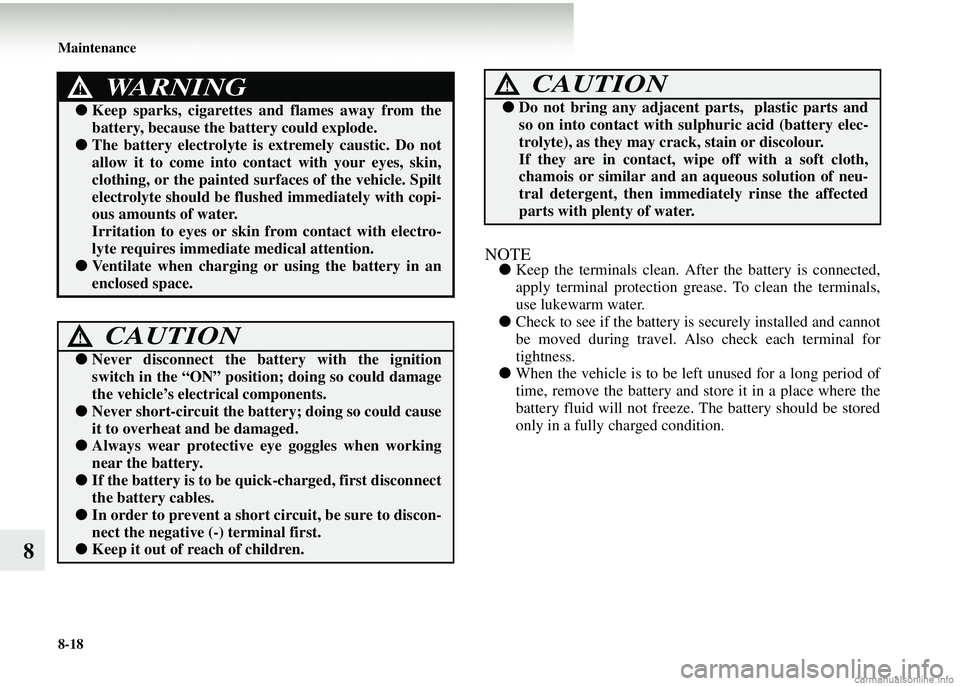
8-18 Maintenance
8
NOTE●Keep the terminals clean. Afte r the battery is connected,
apply terminal protection grease. To clean the terminals,
use lukewarm water.
● Check to see if the battery is securely installed and cannot
be moved during travel. Also check each terminal for
tightness.
● When the vehicle is to be left unused for a long period of
time, remove the battery and store it in a place where the
battery fluid will not freeze. Th e battery should be stored
only in a fully charged condition.
WARNING!
● Keep sparks, cigarettes and flames away from the
battery, because the ba ttery could explode.
●The battery electrolyte is extremely caustic. Do not
allow it to come into cont act with your eyes, skin,
clothing, or the painted surf aces of the vehicle. Spilt
electrolyte should be flus hed immediately with copi-
ous amounts of water.
Irritation to eyes or skin from contact with electro-
lyte requires immediate medical attention.
● Ventilate when charging or using the battery in an
enclosed space.
CAUTION!
● Never disconnect the ba ttery with the ignition
switch in the “ON” position; doing so could damage
the vehicle’s electrical components.
● Never short-circuit the battery; doing so could cause
it to overheat and be damaged.
●Always wear protective eye goggles when working
near the battery.
●If the battery is to be qui ck-charged, first disconnect
the battery cables.
● In order to prevent a short ci rcuit, be sure to discon-
nect the negative (-) terminal first.
●Keep it out of re ach of children.
●Do not bring any adjacent pa rts, plastic parts and
so on into contact with su lphuric acid (battery elec-
trolyte), as they may cra ck, stain or discolour.
If they are in contact, wipe off with a soft cloth,
chamois or similar and an aqueous solution of neu-
tral detergent, then imme diately rinse the affected
parts with plenty of water.
CAUTION!
Page 361 of 450
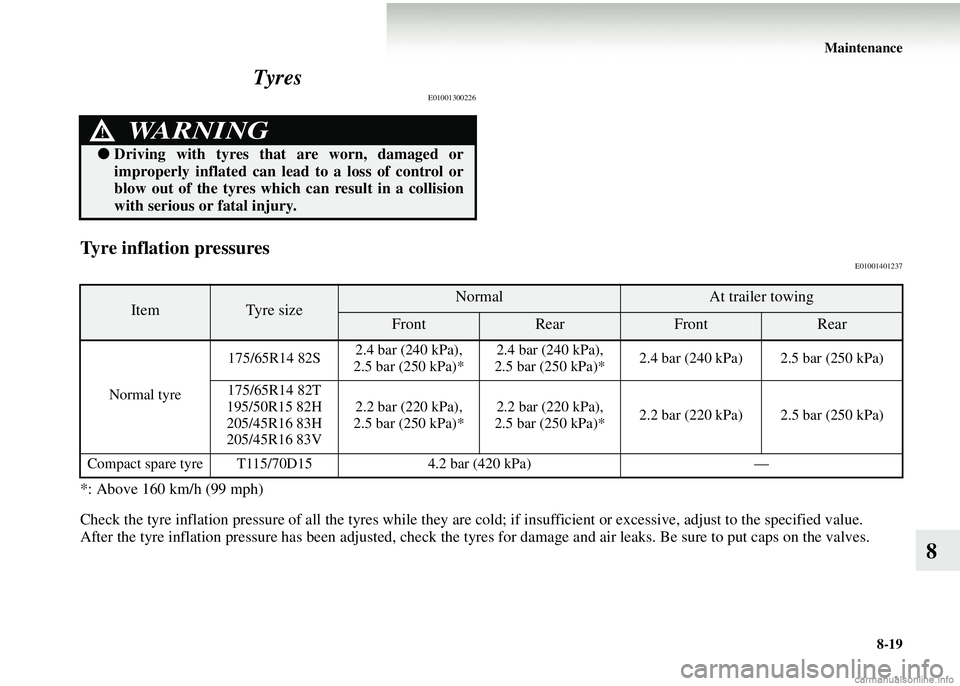
Maintenance8-19
8
Tyres
E01001300226
Tyre inflation pressuresE01001401237
*: Above 160 km/h (99 mph)
Check the tyre inflation pressure of all th
e tyres while they are cold; if insufficient or excessive, adjust to the specified v alue.
After the tyre inflation pressure has been adjusted, check the tyres for damage and ai r leaks. Be sure to put caps on the valves.
WARNING!
●Driving with tyres that are worn, damaged or
improperly inflated can lead to a loss of control or
blow out of the tyres which can result in a collision
with serious or fatal injury.
ItemTy r e s i z eNormalAt trailer towing
FrontRearFrontRear
Normal tyre 175/65R14 82S
2.4 bar (240 kPa),
2.5 bar (250 kPa)* 2.4 bar (240 kPa),
2.5 bar (250 kPa)* 2.4 bar (240 kPa) 2.5 bar (250 kPa)
175/65R14 82T
195/50R15 82H
205/45R16 83H
205/45R16 83V 2.2 bar (220 kPa),
2.5 bar (250 kPa)* 2.2 bar (220 kPa),
2.5 bar (250 kPa)* 2.2 bar (220 kPa) 2.5 bar (250 kPa)
Compact spare tyre T115/70D15 4.2 bar (420 kPa)—
Page 365 of 450
![MITSUBISHI COLT 2008 Owners Manual (in English) Maintenance8-23
8
The speed limit for tyre chains is 50 km/h (31 mph). Remove
the tyre chains as soon as possible on snow-free roads.
Ty r e s i z eWheel sizeMax. chain height [mm]
175/65R14*1, *214x MITSUBISHI COLT 2008 Owners Manual (in English) Maintenance8-23
8
The speed limit for tyre chains is 50 km/h (31 mph). Remove
the tyre chains as soon as possible on snow-free roads.
Ty r e s i z eWheel sizeMax. chain height [mm]
175/65R14*1, *214x](/img/19/34848/w960_34848-364.png)
Maintenance8-23
8
The speed limit for tyre chains is 50 km/h (31 mph). Remove
the tyre chains as soon as possible on snow-free roads.
Ty r e s i z eWheel sizeMax. chain height [mm]
175/65R14*1, *214x5.5 J 12
185/55R15*
315x6.0 J
*
1: Petrol-powered vehicles with turbocharger have 15-inch
brakes, so 14-inch tyres and wheels cannot be used on them.
*
2: Use only 175/65R14 snow tyres (M + S) with the 1500 mod-
els of the petrol-powered vehicles without turbocharger
*
3: Snow tyres (M + S) only
CAUTION!
●
For vehicle with 195/50R15 or 205/45R16 tyres,
chains should not be us ed. The clearance between
the chains and the body is small, and the body might
be damaged.
However, if chains must be used on vehicles with
195/50R15 or 205/45R16 tyres, because of adverse
road conditions such as sn ow or ice, proceed as fol-
lows:
Change all the original tyres (including wheels) to
175/65R14 tyres (14 x 5.5 J wheels) or 185/55R15 M
+ S tyres (15 x 6.0 J wheels) and then use the chains
on the front wheels.
WARNING!
● DO NOT use a jack when fitting the chains, as in the
conditions, the tyres may sl ip on the icy road, caus-
ing the vehicle to slip off the jack.
CAUTION!
● Practice fitting the chains before you need them.
Don’t expect help from ot her people in the cold.
●Choose a clear straight stretch of road where you
can pull off and still be seen while you are fitting the
chains.
● Do not fit chains before you need them. This will
wear out your tyres and the road surface.
●After driving for about 100-300 metres, stop and
retighten the chains.
●Care should be taken with extremes of steering lock
to prevent possible contac t between the chains and
the vehicle body.
● Drive carefully and do no t exceed 50 km/h (31 mph).
Remember, fitting chains is not going to stop acci-
dents from happening.
● When tyre chains are instal led, take care that they
do not damage the disc wheel or body.
Page 370 of 450
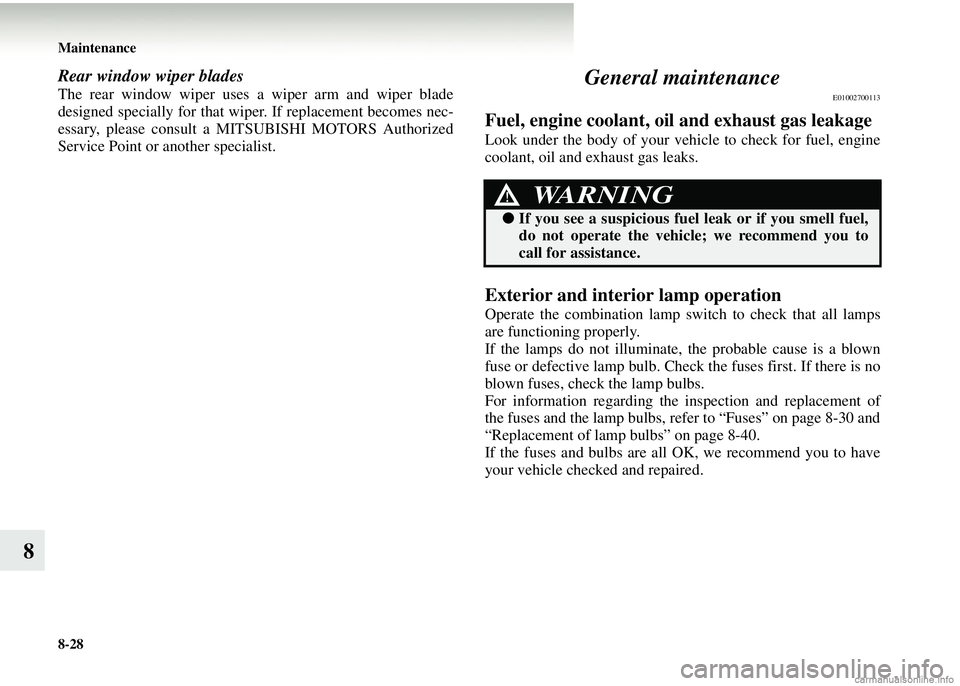
8-28 Maintenance
8
Rear window wiper blades
The rear window wiper uses a wiper arm and wiper blade
designed specially for that wipe r. If replacement becomes nec-
essary, please consult a MITSUBISHI MOTORS Authorized
Service Point or another specialist.General maintenance
E01002700113
Fuel, engine coolant, o il and exhaust gas leakage
Look under the body of your vehicle to check for fuel, engine
coolant, oil and exhaust gas leaks.
Exterior and interior lamp operation
Operate the combination lamp sw itch to check that all lamps
are functioning properly.
If the lamps do not illuminate, the probable cause is a blown
fuse or defective lamp bulb. Check the fuses first. If there is no
blown fuses, check the lamp bulbs.
For information regarding th e inspection and replacement of
the fuses and the lamp bulbs, refer to “Fuses” on page 8-30 and
“Replacement of lamp bu lbs” on page 8-40.
If the fuses and bulbs are all OK, we recommend you to have
your vehicle checked and repaired.
WARNING!
● If you see a suspicious fuel leak or if you smell fuel,
do not operate the vehicle; we recommend you to
call for assistance.
Page 371 of 450
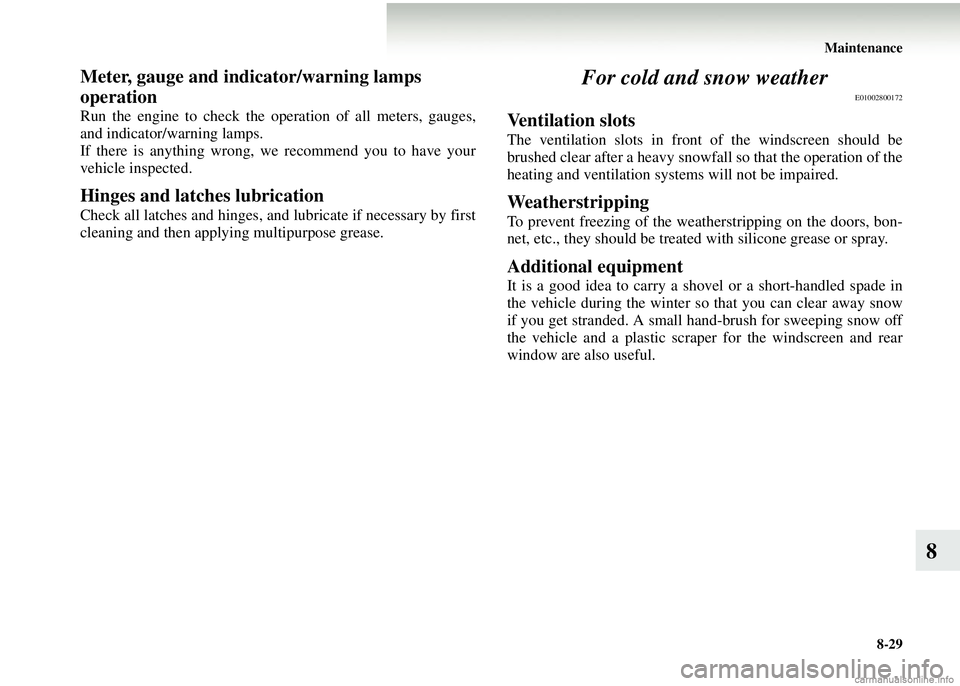
Maintenance8-29
8
Meter, gauge and indicator/warning lamps
operation
Run the engine to check the op eration of all meters, gauges,
and indicator/warning lamps.
If there is anything wrong, we recommend you to have your
vehicle inspected.
Hinges and latches lubrication
Check all latches and hinges, and lubricate if necessary by first
cleaning and then appl ying multipurpose grease.
For cold and snow weather
E01002800172
Ventilation slots
The ventilation slots in front of the windscreen should be
brushed clear after a heavy snowfall so that the operation of the
heating and ventilation systems will not be impaired.
Weatherstripping
To prevent freezing of the weatherstripping on the doors, bon-
net, etc., they should be treated with silicone grease or spray.
Additional equipment
It is a good idea to carry a shovel or a short-handled spade in
the vehicle during the winter so that you can clear away snow
if you get stranded. A small hand-brush for sweeping snow off
the vehicle and a plastic scraper for the windscreen and rear
window are also useful.
Page 375 of 450
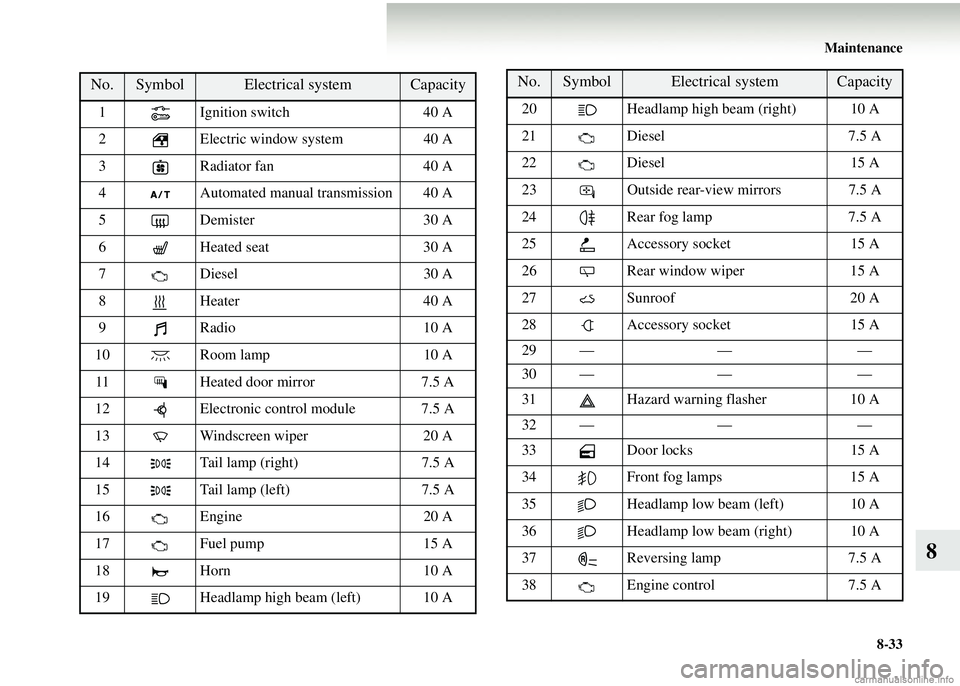
Maintenance8-33
8
No. Symbol Electrical systemCapacity
1 Ignition switch 40 A
2 Electric window system 40 A
3 Radiator fan 40 A
4 Automated manual transmission 40 A
5 Demister 30 A
6 Heated seat 30 A
7 Diesel 30 A
8 Heater 40 A
9 Radio 10 A
10 Room lamp 10 A
11 Heated door mirror 7.5 A
12 Electronic control module 7.5 A
13 Windscreen wiper20 A
14 Tail lamp (right) 7.5 A
15 Tail lamp (left) 7.5 A
16 Engine 20 A
17 Fuel pump 15 A
18 Horn 10 A
19 Headlamp high beam (left) 10 A 20 Headlamp high beam (right) 10 A
21 Diesel 7.5 A
22 Diesel 15 A
23 Outside rear-view mirrors 7.5 A
24 Rear fog lamp 7.5 A
25 Accessory socket 15 A
26 Rear window wiper 15 A
27 Sunroof 20 A
28 Accessory socket 15 A
29 — ——
30 — ——
31 Hazard warning flasher 10 A
32 — ——
33 Door locks 15 A
34 Front fog lamps 15 A
35 Headlamp low beam (left) 10 A
36 Headlamp low beam (right) 10 A
37 Reversing lamp 7.5 A
38 Engine control 7.5 A
No. Symbol Electrical systemCapacity
Page 432 of 450
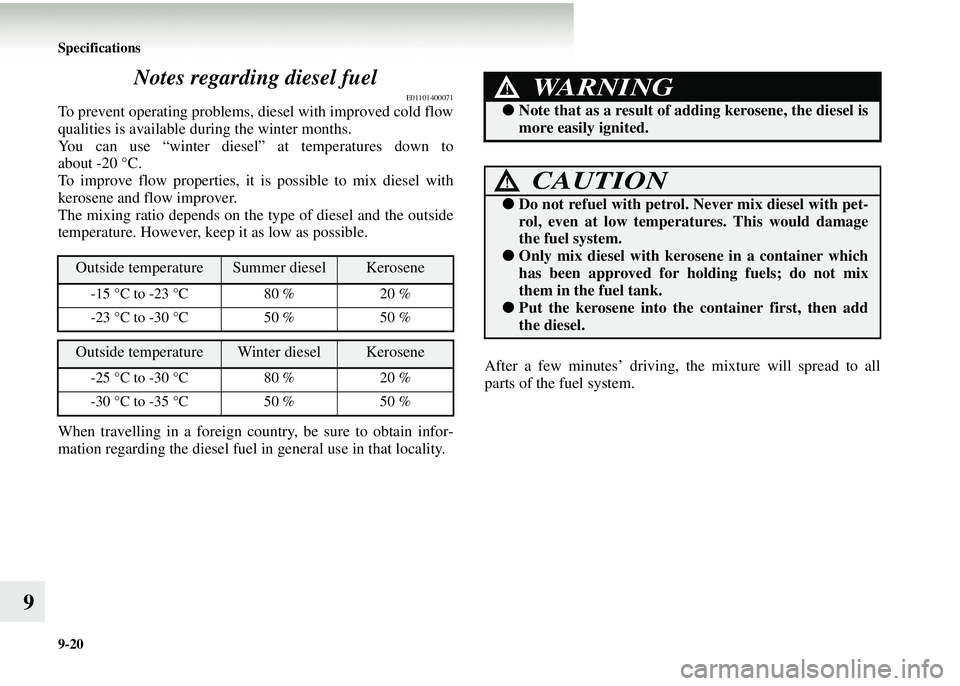
9-20 Specifications
9Notes regarding diesel fuel
E01101400071
To prevent operating problems, diesel with improved cold flow
qualities is available during the winter months.
You can use “winter diesel”
at temperatures down to
about -20 °C.
To improve flow properties, it is possible to mix diesel with
kerosene and flow improver.
The mixing ratio depends on the type of diesel and the outside
temperature. However, keep it as low as possible.
When travelling in a foreign country, be sure to obtain infor-
mation regarding the diesel fuel in general use in that locality. After a few minutes’ driving, the mixture will spread to all
parts of the fuel system.
Outside temperatureSummer dieselKerosene
-15 °C to -23 °C
80 %20 %
-23 °C to -30 °C 50 %50 %
Outside temperatureWinter dieselKerosene
-25 °C to -30 °C 80 %20 %
-30 °C to -35 °C 50 %50 %
WARNING!
●Note that as a result of adding kerosene, the diesel is
more easily ignited.
CAUTION!
●Do not refuel with petrol. Never mix diesel with pet-
rol, even at low tempera tures. This would damage
the fuel system.
● Only mix diesel with kero sene in a container which
has been approved for holding fuels; do not mix
them in the fuel tank.
● Put the kerosene into the container first, then add
the diesel.
Page 437 of 450
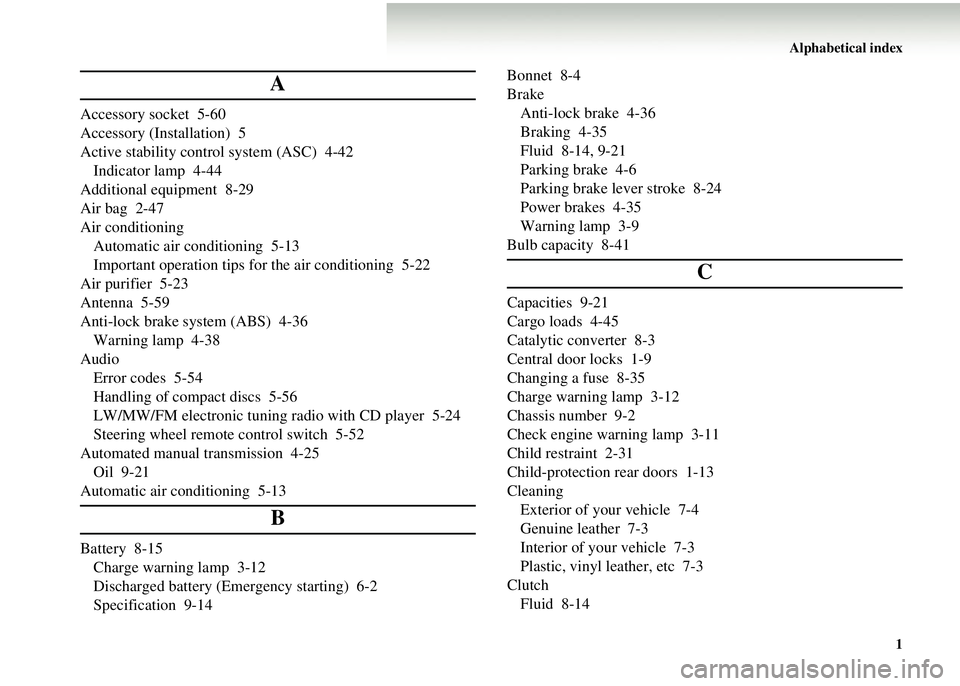
Alphabetical index1
A
Accessory socket 5-60
Accessory (Installation) 5
Active stability control system (ASC) 4-42Indicator lamp 4-44
Additional equipment 8-29
Air bag 2-47
Air conditioning Automatic air conditioning 5-13
Important operation tips for the air conditioning 5-22
Air purifier 5-23
Antenna 5-59
Anti-lock brake system (ABS) 4-36 Warning lamp 4-38
Audio Error codes 5-54
Handling of compact discs 5-56
LW/MW/FM electronic tuning radio with CD player 5-24
Steering wheel remote control switch 5-52
Automated manual transmission 4-25 Oil 9-21
Automatic air conditioning 5-13
B
Battery 8-15 Charge warning lamp 3-12
Discharged battery (Emergency starting) 6-2
Specification 9-14 Bonnet 8-4
Brake
Anti-lock brake 4-36
Braking 4-35
Fluid 8-14, 9-21
Parking brake 4-6
Parking brake lever stroke 8-24
Power brakes 4-35
Warning lamp 3-9
Bulb capacity 8-41
C
Capacities 9-21
Cargo loads 4-45
Catalytic converter 8-3
Central door locks 1-9
Changing a fuse 8-35
Charge warning lamp 3-12
Chassis number 9-2
Check engine warning lamp 3-11
Child restraint 2-31
Child-protection rear doors 1-13
Cleaning Exterior of your vehicle 7-4
Genuine leather 7-3
Interior of your vehicle 7-3
Plastic, vinyl leather, etc 7-3
Clutch Fluid 8-14
Page 438 of 450
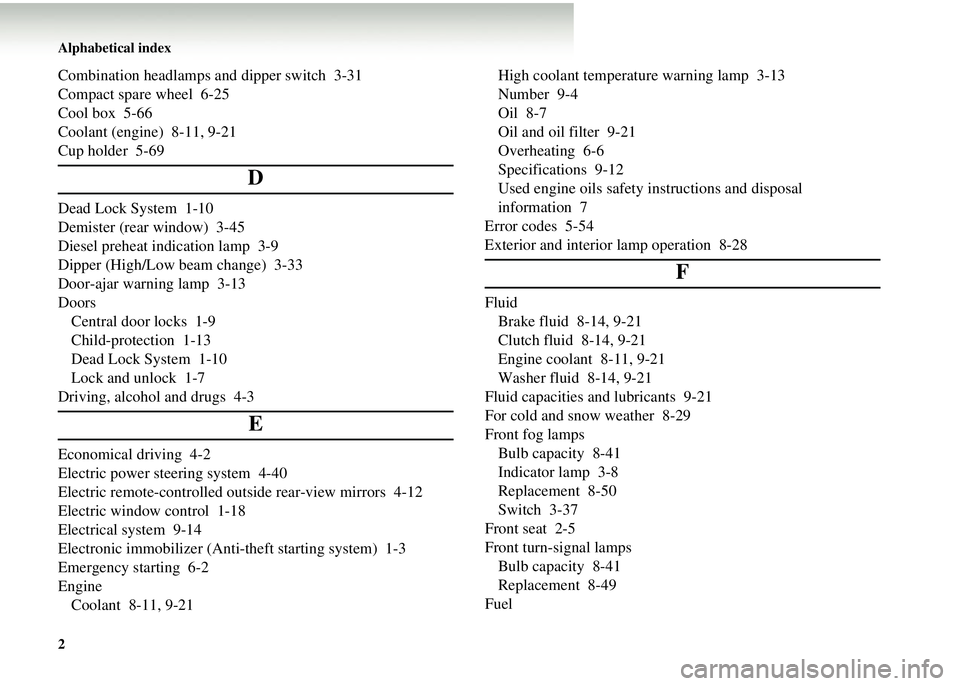
Alphabetical index
2
Combination headlamps and dipper switch 3-31
Compact spare wheel 6-25
Cool box 5-66
Coolant (engine) 8-11, 9-21
Cup holder 5-69
D
Dead Lock System 1-10
Demister (rear window) 3-45
Diesel preheat indication lamp 3-9
Dipper (High/Low beam change) 3-33
Door-ajar warning lamp 3-13
Doors Central door locks 1-9
Child-protection 1-13
Dead Lock System 1-10
Lock and unlock 1-7
Driving, alcohol and drugs 4-3
E
Economical driving 4-2
Electric power steering system 4-40
Electric remote-controlled outside rear-view mirrors 4-12
Electric window control 1-18
Electrical system 9-14
Electronic immobilizer (Anti-theft starting system) 1-3
Emergency starting 6-2
Engine Coolant 8-11, 9-21 High coolant temperat
ure warning lamp 3-13
Number 9-4
Oil 8-7
Oil and oil filter 9-21
Overheating 6-6
Specifications 9-12
Used engine oils safety instructions and disposal
information 7
Error codes 5-54
Exterior and interior lamp operation 8-28
F
Fluid Brake fluid 8-14, 9-21
Clutch fluid 8-14, 9-21
Engine coolant 8-11, 9-21
Washer fluid 8-14, 9-21
Fluid capacities and lubricants 9-21
For cold and snow weather 8-29
Front fog lamps Bulb capacity 8-41
Indicator lamp 3-8
Replacement 8-50
Switch 3-37
Front seat 2-5
Front turn-signal lamps Bulb capacity 8-41
Replacement 8-49
Fuel